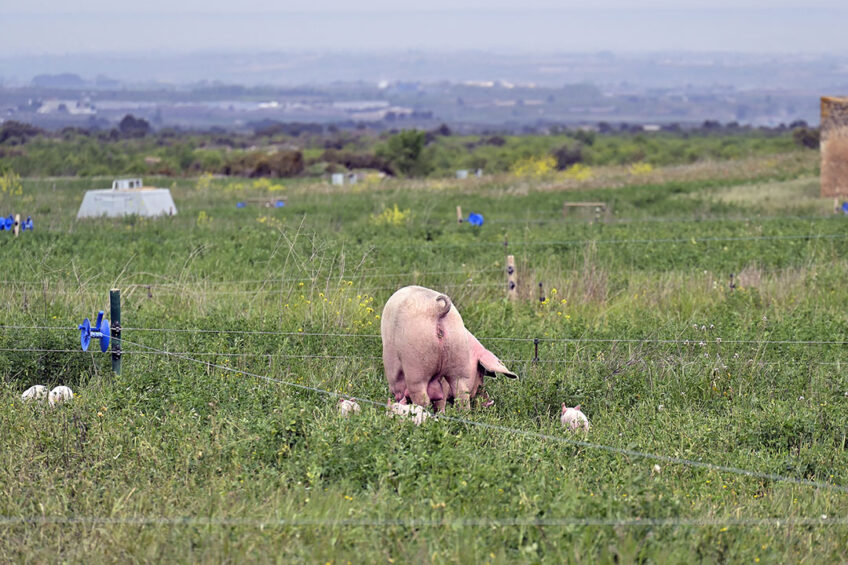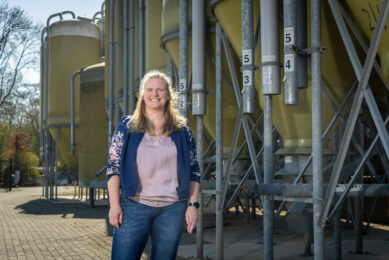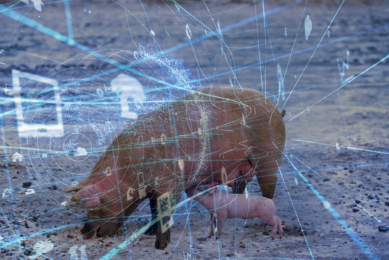Organic pig farming with rapid field rotation

The system is reminiscent of pig production in the UK. This farm, however, is in northern Spain, where organic outdoor production is also taking off. When Eduard Cau Barrufet decided to add an outdoor division to his conventional farm, he deviated from the British approach in 1 respect: he opted for rapid field rotation.
This night is going to be an exciting one. When Pig Progress reaches out to Eduard Cau Barrufet, the farm is getting ready for something new. For the first time, weaning is going to happen at the farm’s new organic pig site. About 100 six-week-old weaners will be moved away from the huts in the field to mobile weaner houses. It was decided to perform this operation at 4am, because that’s when all the piglets can be found inside the huts.
Cau explains, “Catching the pigs for weaning purposes should normally not be much of a problem in the Spanish climate. In summer the piglets huddle together inside the huts to shelter from the strong heat of the sun. In winter, pretty much the same may happen as the piglets are trying to escape from the cold. Yet in spring or autumn, like now, with intermediate temperatures, the piglets could be anywhere during the day. They could also visit the neighbours. The piglets can run freely underneath the fences. That is why we have decided to do the weaning at night.”

Name: Eduard Cau Barrufet, age 53
Function: Owner, Cal Miqueló
Farm: Cal Miqueló is a three-site farrow-to-finish farm in Lleida province, Catalonia, Spain, on 250ha of land. On the first site, near Puiggròs, a conventional 1,200 sow facility is located; on the second, near L’Albi, is a 300-sow organic facility; and on the third site, near Els Omellons, the organic finisher pigs are kept. These sites are located within roughly 15km of each other. The farm also grows olive oil, organic walnuts and pistachio nuts. The solid manure from the organic farm is used on the fields.
![In total, Cal Miqueló has 85 farrowing huts of British design. - Photo: Cal Miqueló In total, Cal Miqueló has 85 farrowing huts of British design. - Photo: Cal Miqueló]() In total, Cal Miqueló has 85 farrowing huts of British design. – Photo: Cal Miqueló
In total, Cal Miqueló has 85 farrowing huts of British design. – Photo: Cal Miqueló

Organic pig production in Spain
When thinking of outdoor pigs in Spain, most people would think of Ibérico pigs, the black breed that is allowed to forage on acorns so the meat develops a rich flavour. Keeping regular pigs organically, however, is a development that has just gained momentum in the EU’s number one pig nation. Cau decided to go that way – and he designed his own method, which could work well under Spanish conditions.
Being a well-travelled man with an open mind, Cau was inspired by farms all over the planet, for instance in the UK, France, the Netherlands as well as Australia. The concept that can be found at his farm, Cal Miqueló, is a mixture of styles mostly reminiscent of UK outdoor production, particularly as it includes the use of huts in fields for sows and their piglets.

Yet there are essential differences. As space is relatively cheap in Spain compared to in the UK, Cau was able to make different choices. He explains, “In the UK for a farm with 1,500 sows you need roughly 50–60ha. And after two years the entire operation needs to be moved to a different location. I didn’t want that; I’m using a similar amount of space for 300 sows, with a very quick rotation system in which the fields have the chance to recover with perennial vegetation. I don’t think a similar system like this exists anywhere in Europe.”

The plan in practice
The plan took shape at a 60ha piece of land in the town L’Albi where the organic facility was started in September 2020. Eduard Cau, his sons and a team of seven other people had been planning it for a number of years. As market demands change, going organic proved to be an opportunity. He said, “For us there are two reasons we wanted to construct this farm. First is that I believe organic farming will lead to good quality food. With that we wanted to be able to reach new customers. And we already have a contract with a processor.

“In addition, in Spain a conventional farm with 1,200 sows like we have is very small. There are many very large companies, for which production is focused on being very efficient. For these producers, it is not easy to implement anything new. For us, however, since we are fairly small, it has been much easier to try something new and move into this business.”
Insemination and gestation
The organic farm currently houses 300 sows, but Cau hopes eventually to grow to 600–700 sows. Insemination and gestation occurs at four insemination zones, each of which has a permanent tent of British design right in the middle. The gestating sows feed on naturally growing vegetation or pre-planted crops that account for 15–20% of their needs. Additional feed is supplied to the sows using open air feeding stalls and, in time, Electronic Sow Feeding equipment will be installed. All in all, in groups of about 25, the sows will have about 1,000m2 at their disposal for about a week, then they will be introduced to the next area of a similar size, while the rest of the land is allowed to recover.
The system means that at any moment of production 90% of the available grounds are in use. And that is on purpose, Cau says, “That way the grasslands have time to recover completely and we will not exhaust the soil, thus there is no need to move elsewhere.”
Farrowing and lactation
For farrowing and lactation, the farm has 85 huts of British design, with patches of about 500m2 per sow. These patches are in use for about seven weeks, as the sows move in there one week prior to farrowing. The sows are not able to access the neighbour’s patch due to the use of electric fences, but the piglets, since they are smaller, will be able to roam freely. After use, the huts are moved to the next site, and the old site is left unused for roughly seven months to allow vegetation to completely recover.
The outdoor sows are a cross between Duroc, Landrace and Large White, which are bred with a PIC Duroc. Cau aims for roughly 20 piglets weaned per sow per year.

Weaner pig barns
After weaning, the piglets will be kept in partly indoor, partly outdoor mobile tent-like sheds. Eight sheds of 100m2 allow for 100 piglets, which will be moved around, again to allow the soil to recover. Each shed has its own drinkers and feeding troughs, and the weaner pigs will be supplied with straw.
Finishing site
Once the pigs weigh about 30kg, after about six weeks in the grower area, they will be transported to an organic finisher pig site near Els Omellons. These pens also have outdoor spaces, with 1m2 per pig indoors and 1.3m2 per pig outdoors.
Currently this facility has a 1,000 pig capacity – this will soon be upgraded to 5,000 pigs.
Until then, a farm near the town Alborja will be used as a temporary solution as well; that location is roughly 75km down the road.
Biosecurity and pig health
Cau aims to achieve the highest biosecurity standards possible – after all, if an animal has to be treated with antibiotics it can no longer be sold as organic. That is why the entire organic farm site at L’Albi has been fenced off properly; the 4km long barrier keeps out unwanted guests. A special truck operates only on-site. Cau says, “In that sense everything is well-structured and exactly like a conventional farm.”
Obviously, both the sows and the piglets will be vaccinated. The sows receive vaccination against Aujeszky’s Disease, parvovirus and erysipelas. In addition, the piglets are also vaccinated against Aujeszky’s Disease and possibly PCV2.
It can happen that pigs do need treatment with antibiotics. That is allowed once, provided that it is an individual treatment. If more than one treatment is necessary, it is not possible to market the animal as organic.
An organic extra
In order to be acknowledged as organic, farms in Catalonia need to be registered with the Catalan Council of Organic Production (CCPAE). Currently the feed is being made at a feed mill, which includes organic ingredients without – obviously – the use of antibiotics. Cau feeds a mixture of 50% organic barley, supplemented with corn, soybeans, peas and potato protein. Up to 5% non-organic components are allowed to be added, and this is mostly made up of high-protein additions. Cau is, however, thinking about producing organic cereals locally, which will pay off especially if the farm does achieve its projected growth to 700 sows, as that would mean 14,000 finisher pigs/year.
Total investment costs for creating the outdoor facility amount to € 1.3 million, which is in addition to the value of the fields and the animals (another € 0.5 million). Currently 3 staff members are employed to keep the organic farm site going.

Marketing the pigs
Cau will sell the finished pigs to slaughterhouse Masia Tero in the nearby town Les Borges Blanques. The animals will be delivered to the slaughterhouse when they reach 120–125kg, the size being pretty identical to the pigs from his conventional farm. The finisher pigs will be 5½ to 6 months old by then. Price-wise he will receive more than double the amount per kg of pork than for a conventional pig; prices were € 1.40/kg live weight in late April 2021. Then again, production and investment costs of organically produced pigs are also substantially higher.
Cau thinks it is important that consumers will be able to tell where their pork comes from. A website explaining all about the farm is under construction, and he says that visitors are more than welcome. How consumers will be able to recognise the Cal Miqueló pork in the supermarkets is not entirely clear yet. Come September 2021, when the first organic pork from Cal Miqueló will hit the market, the answer will be found in supermarkets in north eastern Spain.

Farm visits
With an interactive map Pig Progress takes you around the world one pig production farm at a time.
Weaning
1 week after the interview, 1 question remains. How did the nocturnal weaning process go? Cau explains: “It went really well. We closed the booths at 4am and then we started loading during the day. The operation consisted of loading a sow and her piglets into a small trailer. Next, the piglets were transferred to a larger trailer and the sows would be moved to the mating area in a tent. The piglets were weighed litter by litter. We weaned 26 sows with a total of 336 piglets.”
This farm visit was made possible with the kind cooperation of Rotecna.











